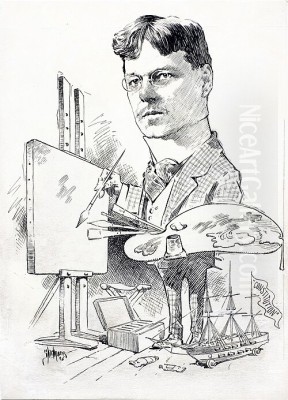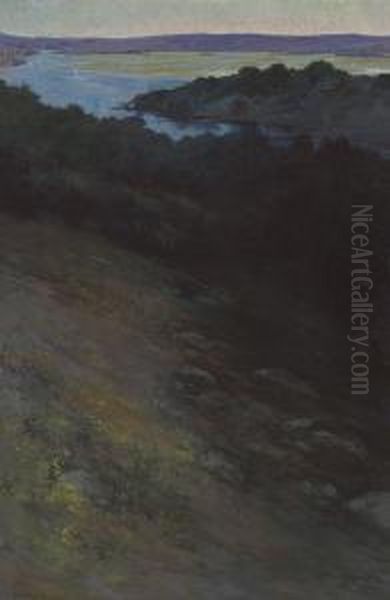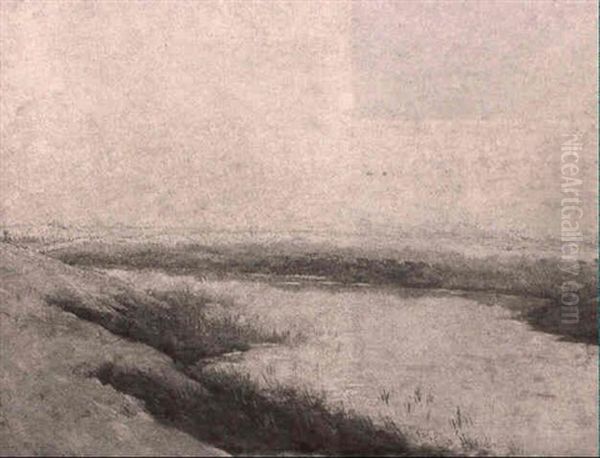
Eric Pape (1870-1938) stands as a significant, if sometimes overlooked, figure in American art history. His career, flourishing at the turn of the 20th century, was characterized by a remarkable versatility that saw him excel as an illustrator, a painter of evocative landscapes and Orientalist scenes, and an influential art educator. Born in an era of dynamic artistic change, Pape navigated the currents of academic tradition, the burgeoning Impressionist movement, and the golden age of illustration, forging a unique path that left a distinct mark on the cultural landscape of his time. His contributions, though diverse, consistently showcased a sophisticated understanding of composition, a vibrant use of color, and a deep engagement with narrative and atmosphere.
Early Life and Formative Influences
Eric Pape was born on October 17, 1870, in San Francisco, California. His origins reflect the immigrant tapestry of America. Sources offer slightly differing accounts of his parentage. One stream of information suggests his parents hailed from Weitenberg (often cited as Wittzenberg) in Hesse, Germany. Another, more detailed account, names his parents as Friederici Ludwig Moritz Pape and Maria Meier, both originally from Zeven in the Province of Hanover, Germany. According to this latter account, his father had been involved in mining and prospecting in California and Nevada before marrying Maria Meier, also from Zeven, in 1868. This background, rooted in both the pioneering spirit of the American West and Germanic heritage, likely contributed to Pape's industrious nature and his broad cultural interests.
His artistic inclinations emerged early, leading him to formal study at the San Francisco School of Design. This institution, a vital center for artistic training on the West Coast, would have provided him with a foundational understanding of drawing, anatomy, and composition. However, like many ambitious American artists of his generation, Pape recognized the necessity of further study in Europe, particularly in Paris, which was then the undisputed capital of the art world.
Parisian Training and European Horizons

Pape's journey to Paris immersed him in an environment teeming with artistic innovation and rigorous academic tradition. He sought instruction from some of the most respected masters of the time, enrolling in the ateliers of Gustave Boulanger, Jules Joseph Lefebvre, and, perhaps most notably, Jean-Léon Gérôme at the prestigious École des Beaux-Arts, or through their independent studios often associated with the Académie Julian. These instructors were stalwarts of the French academic tradition, emphasizing meticulous draftsmanship, historical subjects, and a polished finish.
Gérôme, in particular, was renowned for his historical and Orientalist paintings, characterized by their ethnographic detail and dramatic compositions. Studying under such figures provided Pape with a strong classical grounding. This academic training, with its focus on anatomical accuracy and the human form, would prove invaluable throughout his career, whether in his detailed illustrations or his more painterly fine art. Beyond the structured environment of the academies, Paris itself was a classroom, exposing Pape to the Impressionist and Post-Impressionist movements that were challenging established artistic conventions. This exposure to diverse artistic philosophies undoubtedly broadened his perspective and technical repertoire.
Travels and the Allure of the Exotic
Pape's artistic curiosity extended beyond the studios and salons of Paris. He embarked on significant travels, notably to Egypt and Mexico, where he reportedly engaged in archaeological research. These journeys were not mere tourist excursions but profound experiences that deeply influenced his thematic concerns and visual language. Egypt, with its ancient monuments, vibrant culture, and dramatic landscapes, held a particular fascination for Western artists in the 19th and early 20th centuries, fueling the Orientalist movement.
Pape's immersion in Egyptian culture provided him with a rich trove of imagery and inspiration. This is evident in works like "The Two Great Eras," a painting that, while primarily a landscape, is imbued with the atmosphere and historical resonance of Egypt. His interest in the "exotic" was not superficial; it reflected a genuine engagement with different cultures and historical narratives, which he sought to translate into compelling visual terms. Similarly, his time in Mexico would later inform his illustrations, particularly for works with historical Mesoamerican themes. These travels enriched his palette, expanded his subject matter, and contributed to the distinctive blend of realism and romanticism found in his art.
Return to America: Boston and the Eric Pape School of Art

In 1898, Eric Pape returned to the United States and settled in Boston, Massachusetts. Boston at this time was a vibrant cultural and intellectual hub, with a thriving art scene. It was here that Pape would make one of his most lasting contributions: the founding of the Eric Pape School of Art in the same year. Located in the heart of the city, the school quickly gained a reputation for excellence, attracting students eager to learn from an artist with extensive European training and a broad artistic vision.
Pape served as the school's director and principal instructor for many years. His teaching philosophy likely reflected his own diverse training, balancing classical discipline with an encouragement of individual expression. The school offered courses in drawing, painting, and illustration, catering to the growing demand for trained commercial artists as well as aspiring fine artists. Pape's role as an educator was significant, as he helped shape a new generation of American artists. Among his most notable students was N.C. Wyeth, who would go on to become one of America's foremost illustrators, and whose early style showed discernible influences from his teacher. The establishment of the school solidified Pape's position within the Boston art community and demonstrated his commitment to fostering artistic talent.
Pape the Illustrator: Master of Narrative and Atmosphere
While Pape was a capable painter, his reputation during his lifetime and arguably his most widespread impact came through his work as an illustrator. This was the "Golden Age of Illustration," a period when magazines and books were lavishly illustrated, and illustrators were celebrated figures. Pape's skill in draftsmanship, his dramatic sense of composition, and his ability to evoke atmosphere made him highly sought after.
He contributed numerous illustrations to prominent periodicals of the day, including Scribner's Magazine, The Century Magazine, and Cosmopolitan. These magazines reached a vast audience, bringing Pape's art into homes across America. His illustrations were not mere accompaniments to text but powerful visual interpretations that enhanced and often defined the narratives they accompanied. He was particularly known for his work on children's books and historical fantasies.
One of his most celebrated achievements in illustration was his work for Lew Wallace's historical novel, The Fair God: Or, The Last of the 'Tzins, A Tale of the Conquest of Mexico. Pape's illustrations for this book, often executed in a rich, detailed style, captured the drama and exoticism of the Aztec civilization and the Spanish conquest. These works showcased his ability to blend historical accuracy with imaginative flair, creating images that were both informative and deeply evocative. His illustrations, often characterized by strong chiaroscuro and dynamic figures, set a high standard in the field and influenced other illustrators, including his student N.C. Wyeth, who, like his mentor Howard Pyle, would also become a master of historical and adventure illustration.
Pape the Painter: Impressionism, Landscapes, and Orientalism
Beyond his prolific career as an illustrator, Eric Pape was also a dedicated painter, exploring various genres and styles. His painterly output included Impressionistic landscapes, portraits, and Orientalist scenes, reflecting the breadth of his artistic interests and training. His engagement with Impressionism is evident in works like "Early Morning, Annisquam" (c. 1900). This painting, depicting a serene coastal scene in Massachusetts, demonstrates Pape's adeptness at capturing the fleeting effects of light and atmosphere, hallmarks of the Impressionist style. His palette is bright, his brushwork visible, conveying the freshness and immediacy of the moment. Such works place him within the broader current of American Impressionism, a movement that adapted French Impressionist principles to American subjects and sensibilities, with artists like Childe Hassam, John Henry Twachtman, and William Merritt Chase leading the way.
Pape's Orientalist paintings, inspired by his travels in Egypt, represent another significant facet of his oeuvre. Works like "The Two Great Eras" showcase his fascination with Egyptian history and culture. These paintings often combined landscape elements with figures, creating scenes that were both picturesque and imbued with a sense of historical grandeur or mystery. His approach to Orientalism, like that of his teacher Gérôme or fellow American Orientalist Frederick Arthur Bridgman, involved a careful rendering of detail and an effort to convey the perceived exoticism of the East, though viewed through a Western lens. His paintings often featured rich colors and strong contrasts of light and shadow, enhancing their dramatic impact.
His versatility extended to portraiture and other figural compositions, where his academic training in drawing the human form was evident. While perhaps less known than his illustrations or Impressionistic landscapes, these works further demonstrate the range of his technical skill and artistic ambition.
Artistic Style and Techniques
Eric Pape's artistic style cannot be easily categorized under a single label, which is a testament to his versatility and his willingness to explore different modes of expression. His work represents a confluence of several major artistic currents of his time. The rigorous academic training he received in Paris under Gérôme, Lefebvre, and Boulanger provided him with a strong foundation in draftsmanship, anatomy, and classical composition. This is evident in the clarity and precision of his illustrations and the structural integrity of his paintings.
Simultaneously, Pape was receptive to the innovations of Impressionism. He adopted Impressionist techniques, particularly in his landscape paintings, using broken brushwork, a lighter palette, and a focus on capturing the transient effects of light and color. This allowed him to convey a sense of immediacy and vibrancy in his depictions of nature.
His travels, especially to Egypt, infused his work with Orientalist themes and a rich, often exotic, palette. This interest in non-Western cultures and historical narratives added another layer of complexity to his art, aligning him with a broader fascination with the "exotic" prevalent in late 19th and early 20th-century art. He skillfully blended these diverse influences – Western classicism, Impressionism, and Orientalism – often with a touch of Primitivism or a romantic sensibility. His use of color was typically rich and evocative, and he demonstrated a keen understanding of light and shadow to create mood and drama, particularly in his illustrative work.
Influence, Legacy, and Recognition
Eric Pape's influence was felt in several areas. As an educator, through his Eric Pape School of Art, he played a direct role in training a new generation of artists. His most famous pupil, N.C. Wyeth, went on to become a towering figure in American illustration, and Pape's emphasis on strong narrative and dramatic composition likely left an impression on Wyeth's development. The school itself contributed to the vitality of the Boston art scene.
As an illustrator, Pape was part of the "Golden Age" that saw artists like Howard Pyle, Edwin Austin Abbey, and Maxfield Parrish elevate illustration to a respected art form. His work for major magazines and books brought art to a wide public and helped shape popular visual culture. His historical and fantastical illustrations, in particular, were highly regarded for their imaginative power and technical skill.
In painting, Pape contributed to the American Impressionist movement and the Boston School, which included artists like Edmund C. Tarbell and Frank W. Benson, known for their refined depictions of genteel life and luminous landscapes. While perhaps not as central to these movements as some of his contemporaries, his work in this vein was accomplished and demonstrated his versatility. John Singer Sargent, though often working abroad, was another towering figure whose technical brilliance and modern sensibility influenced many American artists of this period, including those in Boston.
In recent years, there has been a renewed interest in Pape's work. Exhibitions, such as a notable one at the Hammond Castle Museum which reportedly featured over two dozen of his works (many unseen for nearly a century and considered the largest display of his art globally), have helped to bring his achievements to a new audience. His works are held in various public and private collections.
Eric Pape in the Art Market
The auction market provides some insight into the valuation and appreciation of Eric Pape's work. Like many artists whose careers spanned different genres, the market performance of his works can vary. His oil paintings, particularly his American Impressionist landscapes, have achieved notable prices. For instance, "Early Morning, Annisquam, Massachusetts" (1900), a substantial oil on canvas measuring 46 x 30 1/2 inches, was offered at Christie's with an estimate of $70,000 to $100,000. In a 2009 auction (some sources cite 2005 for a similar sale or re-offering), it sold for $62,500, a significant sum, though slightly below the lower end of its estimate. This indicates a solid demand for his finer paintings.
His illustrations also command interest, especially original artwork for his published pieces. An original illustration for "The Fair God," likely the piece titled "She Gave Him The Signal," reportedly sold at Christie's for $45,000. This price reflects the high regard for original illustrations from the Golden Age and Pape's skill in this medium. The market for Pape's work, while perhaps not reaching the highest echelons of some of his more famous contemporaries, shows a consistent appreciation for his skill and historical importance. Prices can fluctuate based on subject matter, condition, provenance, and the prevailing tastes of the market, but there is an established collector base for his art.
Conclusion: A Multifaceted Artist for a New Century
Eric Pape died on November 7, 1938, in New York City, leaving behind a rich and varied body of work. He was an artist who successfully navigated the diverse artistic landscape of the late 19th and early 20th centuries. His career bridged the gap between fine art and commercial illustration, demonstrating excellence in both realms. From the disciplined halls of Parisian ateliers to the sun-drenched coasts of New England and the historic lands of Egypt, Pape absorbed a wide range of influences and translated them into a distinctive artistic voice.
His contributions as an illustrator brought vivid imagery to countless readers, while his paintings captured the beauty of the American landscape and the allure of distant cultures. As an educator, he helped to nurture the talents of others, ensuring a continuity of artistic practice. Eric Pape's legacy is that of a versatile and skilled artist, a dedicated teacher, and a significant contributor to the American art scene at a pivotal moment in its development. His work continues to be appreciated for its technical mastery, its imaginative scope, and its embodiment of the artistic spirit of his era.